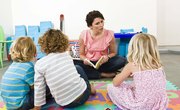Kids in the first grade are usually six- or seven-years-old. They are learning to read and understand new concepts in mathematics and science at the most basic of levels. It is also the time to begin teaching them how to be a valuable member of society. This starts in the classroom in small ways and does not even necessitate using large words or concepts. Teach first graders about the responsibilities of citizenship by incorporating them in daily classroom activities.
Step 1
Create a list of rules for the classroom and explain to the first graders that the class is a community. Ask the kids why the community/class needs rules and share with them that all citizens of the classroom community need to be honest, show respect and take responsibility for their actions. Let the kids know there will be consequences when the rules are broken.
Step 2
Discuss the five traits of a good citizen: respect, courage, responsibility, compassion and honesty. Use simple terms and examples. Tell kids they show respect every day when they wait for others to finish their sentences before speaking. Teach them to express courage by stepping in when others are being bullied. Remind the kids of their responsibility to place their name on their homework. Encourage them to show compassion for others by placing themselves in another person's shoes. Express your belief in telling the truth; when people tell the truth they don’t have to worry about remembering the lies they told.
Step 3
Read short stories about people who were or are good citizens and ask the kids to explain how each person showed good citizenship. The stories should be short and focused on the acts that show good citizenship in order to keep the kids' attention. Pass out short biographies on people like Martin Luther King Jr., Abraham Lincoln, Rosa Parks, Woodrow Wilson, Oprah Winfrey and Audrey Hepburn. For example, when discussing Audrey Hepburn, point out the compassion she showed by working to improve conditions for children with the United Nations Children's Fund (better known as UNICEF).
Step 4
Assign classroom chores on a rotating schedule. It will teach children that responsible citizens are invested in working together to keep their community clean. Students can run errands, clean their desks, cross dates off of the class calendar and wipe clean the chalkboard or dry erase board.
Related Articles
References
Writer Bio
Stacy D. Cooper received her Bachelor of Arts degree from Indiana University with an emphasis in writing and literature. She is fascinated with books, reads constantly and is the owner and publisher of a book review blog and website. She currently writes for online content providers while raising her two daughters.











